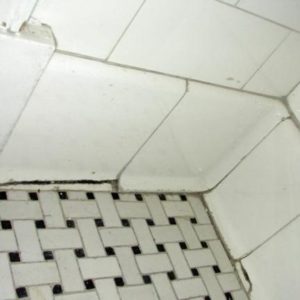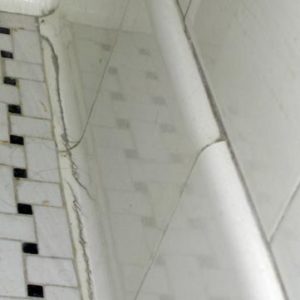The ceramic base cove tiles in our bathroom are nearly all cracked at the point where they transisition form horizontal to vertical (see pictures). I plan on replacing them and was wondering what I could do to prevent the problem from recurring.
I am speculating that thermal expansion/contraction of the floor tile couls have caused the cracking…is this a reasonable assumption, and what should be done in order to prevent the new tile from cracking in the same spot?





















Replies
Are the floors/walls under them new?
Thats my guess....
What kind of substrate did you use?
We need more information here.
Funny how some peeps give tons of info and no pictures and some give pictures with little information......OK OK...keep going with specs.
Be well
andy
My life is my practice!
http://CLIFFORDRENOVATIONS.COM
Well, if its specs you want...it's a small bathroom (7'x6' or so), with ceramic tile floor, 3x6 "subway" wall tiles to half-height, painted plaster above that.
As far as I know, everything in the room is original to the house (built 1928). Cast iron pedestal sink had seperate hot & cold water water spigots, etc. So I have no idea what's under the tile floor or walls.
I don't mind doing some investigation if that would help...I'll be knocking out all the base tiles anyway...
It is probably due to a combination of things. There is no proper subbase for the old tiles. Old base mold tiles do not have beefed up cross sections at the fillet area the cracks are forming in. And, the grout lines are so tight, expansion of the floor tiles probably put repeated stress on those base mold tiles over the years (those tiles look like an early 20's, or earlier vintage).
With a new subbase and modern tiles, your replacement tiles should be fine.
...that's not a mistake, it's rustic
You're right on the money (1920's vintage everything). So you think that the heavier cross-section of a more modern cove tiles would solve the problem? Excuse my ignorance, but what is typically used as a sub-base?
Steve
Does the floor have a mud bed under it?
Are the wall and base tiles newer than the floor?
Is this an older home? 50+/-
My Guess is that the walls are settling for some reason and putting pressure on the Cove of the base tiles.
You may find rotten wall plates behind the tile.
Got Leaks? Plumbing or Roof.
Done any work above this bath?
Below?
Did the house sit unoccupied for over a winter?
with no heat?
Get ready to find something bad when you take off those tiles.
Got $$$$$$$$$ ?
Mr T
Do not try this at home!
I am an Experienced Professional!
You're scaring me now...this was supposed to be simple :)
To answer your questions, though:
- Everything is original to the house (1928), as far as I know
- Don't know what's under the floor tile
- No work done, always occupied/heated, no known or obvious leaks (although this is a bathroom with a tub & kids; grout is not in the best shape throughout), no settlement problems anywhere else in the house (discovered that window openings are all square(!) during window replacement project).
Well, I'm taking off the base tiles regardless...I can let you know how bad the "something" is back there once they're off...
This is a confusing one to me.........
If yer gonna rip it out do a mud job or at least lay in some wire lathe under the thinset job you do, do.
Very interesting problem...My house is 325 years old and I havent a problem at all with the tile work I've just done.
Post a picture of the house from outside if you wouldn't mind
Ne well
andyMy life is my practice!
http://CLIFFORDRENOVATIONS.COM
The floor tiles look just like the ones I recently removed from my 1929 home. It had wire lath and about 1" of mud on the walls and about 1-1/2" of mud over about 1-1/2" of concrete on the floor. As soon as you start, you will have likely opened a can of worms. Unless you're one very lucky fellow, you will have remodeled the whole bath by the time you are done. I hated tearing mine out, because it had served well for 70 years and once I started, I knew why. Everything was very solid and very heavy. I doubt it will surrender just those tiles without damage to surrounding areas.
Those cracks are not new are they?
Al Mollitor, Sharon MA
The cracks are not new - they were there when we moved in a few years ago. I'm pretty daunted by the notion of having this base replacement turn into a full; on the other hand, as the inevitable water that gets on the floor makes it's way through those cracks, it can only make things worse (rotted wood...).
Steve
>> ... as the inevitable water that gets on the floor makes it's way through those cracks ...
If those cracks weren't there, wouldn't the inevitable water make it's way through cracks in the grout, or cracks between the floor tiles and the grout? I have a hard time believing a 75 year old tile job would be waterproof if it weren't for the cracked base tiles.
And besides that, what you doing taking pictures in my mama's bathroom?
Edited 12/31/2003 5:43:34 PM ET by Uncle Dunc
80 years old and onlt that cracking. could it just be that they are old. put in before a/c so no thermal protection. I do not think there is a problem, just old.
The best employee you can have but you wouldn't want him as a neighbor " He the shifty type"
The floor looks good.
What I can see of it.
If it is a fullbed mud job, which is pretty likely, it should be fine.
You don't want to tear out a mud bed tile floor if you don't have to!!!
Mr T
Do not try this at home!
I am an Experienced Professional!
IMHO the problem is that the wall and the floor are moving separate from each other.
I have a similar effect in a bath with a mud floor, and the wall tiles are on a solid masonry wall. from summer to winter the floor joists shrink/expand and the joint between wall and floor cracks. fortunately there is not a cove tile at the transition so the grout cracks out. I put silicone in place of the grout and the problem went away as the silicone moves. If there were coves at that joint they would undoubtably crack.you probably need to figure out how to let it move when you replace the coves.ie don't replace the coves.
Bud
I can't say what caused it but it is not at all unusual. If you think about it; if the base cove tile are stuck to both the wall and the floor they're gonna crack sooner or later.
Yuo are NOT going to fix it even IF you could find replacement tile. Clean it up, force some Phenoseal into the cracks and live with it. Or gut the whole room.
Eric
Edited 12/31/2003 6:14:39 PM ET by firebird
This is an easy one. Typically Cove Base tile is only thinsetted on the walls not the floor, and is left hovering over the floor to float. The space between the cove and the floor is caulked.
Your installer thinsetted the cove base to the wall and to the floor. One of the planes moved, the other didn't. The tile cracked.
When you replace them, dig out all the thinset you can and clean off the backs of the good tiles that you dig out. Get all the grout out, too. Soak the setting bed in water or run a sponge over it and thinset the heck out of it on the walls only. Put no thinset on the 3/4" or so of the floors. Just let it lie there. If that really upsets you, then use a caulk on the floor.
Once the thinset is cured, the next day or so, grout the tile and caulk the space between the cove tile and the floor tile with a sanded caulk to match your grout.
Good Luck
Boris
"Sir, I may be drunk, but you're crazy, and I'll be sober tomorrow" -- WC Fields, "Its a Gift" 1934
Right on the money ...
except for the "typical" comment ...
at that age .... typically ... this was the installation.
Simply ... the walls and floor were a full mud job install ....
and the base cove was installed tying both the floor and the wall together
and we all know what's gonna happen then ... a crack.
Gotta go ... Kid's awake!
Jeff
Buck Construction Pittsburgh,PA
Artistry in Carpentry
...but they didn't have modern elastomeric caulking back then.
Gotta go... I am half asleep.
Hey All, thanks for the input.
I'm gonna go with Boris's suggested method (since he said what I thought I wanted to hear)...I'll let you know how it goes.
Steve
I would just replace them and hope that your new tile looks that good 70 years from now. In that amount of time a lot of things could happen. All tile has small faults in it from the firing process and over time cracks will appear. The same with the glaze. We now pay a premium for tile that has a crazed glaze to make it look older.